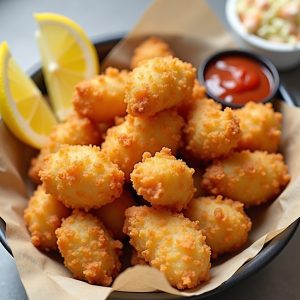
AI generated image
Chef's Tip
Soak the cleaned clams in buttermilk for 30 minutes before coating to help the batter adhere better and add tenderness. When frying, work in small batches and maintain oil temperature between 360-375°F for the crispiest results.
Instructions
- Rinse clams thoroughly with cold water and drain well. Place in a bowl with buttermilk, cover, and refrigerate for 30 minutes.
- In a large bowl, whisk together flour, cornmeal, cornstarch, baking powder, salt, and pepper.
- Heat oil in a heavy-bottomed pot or deep fryer to 365°F.
- Set up a wire rack over a baking sheet lined with paper towels for draining.
- Working in small batches, remove clams from buttermilk, letting excess drip off.
- Dredge clams in the flour mixture, shaking off excess. For extra crispiness, dip coated clams briefly back in buttermilk and then in flour mixture again.
- Carefully add clams to hot oil, about 10-12 at a time to avoid overcrowding and dropping the oil temperature.
- Fry until golden brown and crisp, about 1-2 minutes. Adjust heat as needed to maintain oil temperature.
- Using a slotted spoon or spider, transfer fried clams to the prepared rack to drain. Sprinkle lightly with salt while still hot.
- Repeat with remaining clams, allowing oil to return to temperature between batches.
- Serve immediately with tartar sauce, lemon wedges, and coleslaw.
Plating
Pile the crispy fried clams in a serving basket lined with parchment paper or on a plate with a paper liner. Place a small dish of tartar sauce to one side and add lemon wedges. Serve coleslaw in a separate small bowl alongside. For a traditional presentation, add a few crispy French fries to the plate.
Storage & Reheating
Fried clams are best eaten immediately after cooking. Leftovers can be stored in an airtight container in the refrigerator for up to 1 day, though they will lose their crispness. Reheat in a 375°F oven for 5-7 minutes until warmed through and somewhat crisp again.
About This Recipe
This preparation honors the iconic fried clam shacks found along New England's coast. While many restaurants use clam strips (the foot of larger clams), this recipe uses whole belly clams with their sweet, tender centers intact. The light, crispy coating amplifies rather than masks the clams' natural briny flavor, creating a more authentic version of this beloved regional specialty.
